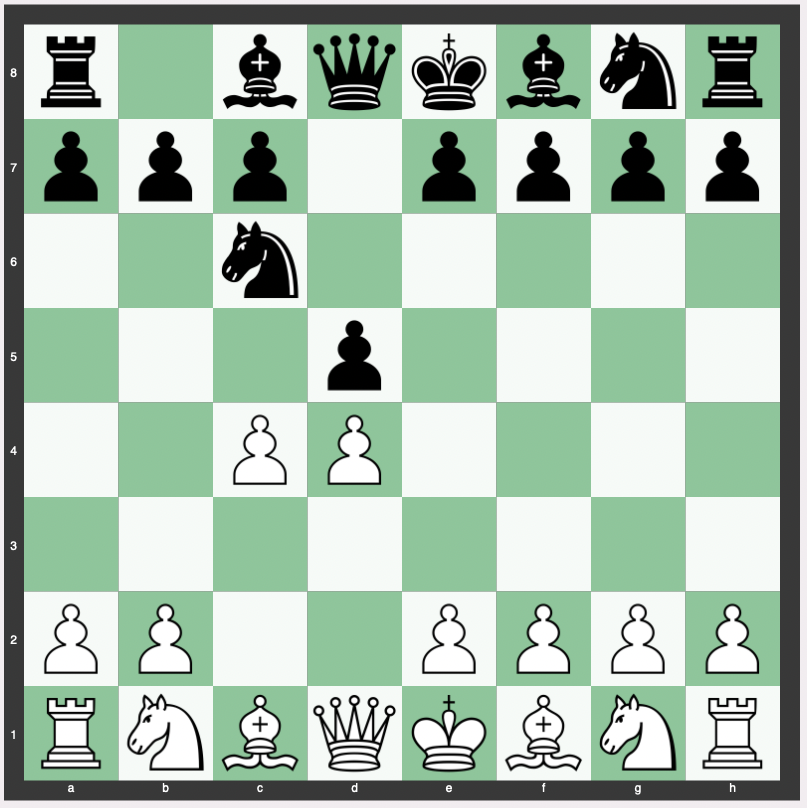The Chigorin Defense is a chess opening named after the Russian master Mikhail Chigorin.
It is a fascinating and unusual response to the Queen’s Gambit that challenges many of the traditional principles of chess opening theory.
Throughout this article, we’ll look at the move order, theory, strategy, and purpose behind this defense.
We’ll also look into its variations, historical development, suitability for beginners or intermediates, and its frequency of play at the grandmaster level.
Move Order of the Chigorin Defense
- d4 d5
- c4 Nc6

This is the basic sequence of moves that define the Chigorin Defense.
The opening is characterized by the immediate development of the knight to c6, rather than the more traditional moves that aim to control the center with pawns.
Theory, Strategy, and Purpose of the Chigorin Defense
The Chigorin Defense flouts conventional wisdom by neglecting early central pawn control.
Instead, it aims for rapid piece development, particularly focusing on bringing the knights into play early.
This often leads to unbalanced positions, where understanding the underlying principles is crucial.
The primary idea is to challenge White’s center, creating opportunities for active piece play and tactical complexity.
Variations of the Chigorin Defense
Several variations can stem from the Chigorin Defense, depending on White’s response.
- Mainline: 3.Nf3 Bg4 – This is a key line where Black immediately puts pressure on the d4 pawn.
- Chigorin Exchange Variation: 3.cxd5 Qxd5 – Aiming for a more symmetrical and solid structure.
- Anti-Chigorin Systems: White may also choose moves like 3.Nc3 or 3.e3 to avoid the main lines.
Understanding these variations helps in navigating the complex landscape that this opening can present.
Evaluation of the Chigorin Defense
The evaluation of the Chigorin Defense is +0.80 to +1.00.
Sample Continuation Lines of the Chigorin Defense
Continuation lines of the Chigorin Defense include:
3. Nf3
3. Nf3 Bg4 4. cxd5 Bxf3 5. gxf3 Qxd5 6. e3 Nf6 7. Nc3 Qh5 8. Bd2 e6 9. a3 O-O-O 10. Be2 Qh3 11. f4 g6 12. Qa4
3. Nf3 e6 4. a3 Nf6 5. Nc3 Be7 6. e3 O-O 7. Qc2 dxc4 8. Bxc4 Bd6 9. O-O e5 10. h3 h6 11. Ba2 exd4 12. exd4 Ne7 13. Re1 c6 14. Ne5 Bf5 15. Qb3
3. Nf3 e6 4. a3 Nf6 5. Nc3 Be7 6. e3 O-O 7. Qc2 dxc4 8. Bxc4 Bd6 9. O-O e5 10. d5 Ne7 11. Rd1 Ne8 12. e4 Ng6 13. Re1 Bg4 14. Be2 Bxf3
3. cxd5
3. cxd5 Qxd5 4. e3 e5 5. Nc3 Bb4 6. a3 Bxc3+ 7. bxc3 Nf6 8. c4 Qd8 9. d5 Ne7 10. Nf3 e4 11. Nd4 c6 12. dxc6 bxc6 13. Be2 O-O 14. O-O c5 15. Nb5 a6 16. Nc3 Rb8 17. Qc2 Qc7 18. Nxe4 Nxe4
3. cxd5 Qxd5 4. e3 e5 5. Nc3 Bb4 6. a3 Bxc3+ 7. bxc3 Nf6 8. c4 Qd8 9. d5 Ne7 10. Nf3 e4 11. Nd4 c6 12. dxc6 Nxc6 13. Be2 Qa5+ 14. Qd2 Qg5 15. Nxc6 bxc6 16. Qd6 Qxg2 17. Rf1 Nd7 18. Bb2 Qg6
3. cxd5 Qxd5 4. e3 e5 5. Nc3 Bb4 6. a3 Bxc3+ 7. bxc3 Nf6 8. c4 Qd8 9. d5 Ne7 10. Nf3 e4 11. Nd4 c6 12. dxc6 bxc6 13. Bb2 O-O 14. Be2 Qa5+ 15. Qd2 Qg5 16. h4 Qxg2 17. O-O-O Rb8 18. h5 Rxb2 19. Kxb2 h6
3. Nc3
3. Nc3 e6 4. Nf3 Bb4 5. Bg5 Nge7 6. cxd5 Bxc3+ 7. bxc3 exd5 8. e3 b6 9. Bd3 f6 10. Bf4 Bf5 11. c4 Bxd3
3. Nc3 e6 4. Nf3 Bb4 5. e3 Nf6 6. Bd2 O-O 7. a3 Bxc3 8. Bxc3 b6 9. b3 a5 10. Bb2 Ba6 11. Rc1 Ne7 12. Bd3 a4 13. b4 Bxc4 14. Bxc4
3. Nc3 e6 4. Nf3 Bb4 5. e3 Nf6 6. Bd2 O-O 7. a3 Bxc3 8. Bxc3 Ne7 9. c5 Ne4 10. Qc2 b6 11. b4 a5 12. Bd3 bxc5 13. dxc5 Nxc3 14. Qxc3 c6 15. O-O Qc7 16. Rfc1
History of the Chigorin Defense
The Chigorin Defense was popularized by Mikhail Chigorin, a leading Russian player of the late 19th century.
Chigorin was known for his creative and unconventional play, and this defense is a clear reflection of his chess philosophy.
While it has never been a mainstream choice, it has been employed by several strong players throughout history, contributing to its enduring intrigue.
Is the Chigorin Defense Good for Beginners or Intermediates?
The Chigorin Defense may be considered somewhat risky for beginners due to its unconventional nature.
Intermediate players with an understanding of the underlying concepts and strategies may find it more appealing.
It offers rich tactical opportunities, but it also requires a deep understanding of the resulting positions.
How Often Is the Chigorin Defense Played at the Grandmaster Level?
The Chigorin Defense is rarely seen at the grandmaster level, especially in top-tier competitions.
Its non-traditional approach makes it less appealing to players who prefer well-trodden paths.
However, some grandmasters have used it as a surprise weapon, particularly in games where they wish to avoid their opponent’s preparation.
Chigorin Defense; QGD
Conclusion
The Chigorin Defense is a unique and intriguing chess opening that offers a departure from traditional opening principles.
While it might not be the best choice for absolute beginners, it can be a fascinating option for intermediate players who are drawn to unconventional strategies.
The rarity of the Chigorin at the grandmaster level attests to its non-mainstream status, but also to its potential as an unexpected tool in one’s opening repertoire.
Its rich history, complex variations, and distinctive approach to the game continue to make the Chigorin Defense a subject of study and a symbol of creativity in chess.


